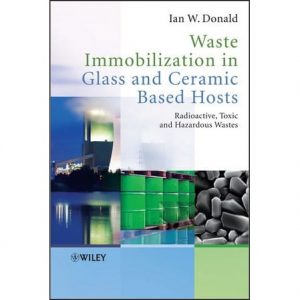 Since 2005 as module director at Nuclear Technology Education Consortium of United Kingdom I have delivered a core course related to processing, storage and disposal of nuclear waste. The difficulties in teaching such courses are due to the absence of relevant and up-to-date reference manuals. It is not easy to find good handbooks able to cover all aspects of such topics. Professor Ian W. Donald has for a long time been known among nuclear experts not only for his original works but also for his excellent overviews. The recent publication of his book “Waste Immobilisation in Glass and Ceramic Based Hosts” is a real success. I will always recommend students, as well as any specialist working with waste-immobilising materials, to use this book. First, it covers in detail not just glasses and ceramics intended for immobilisation; it is a widely-covering reference of all the best achieved in the last years in nuclear waste management. It includes a number of overviews together: what is waste, waste classes and volumes, toxicity and hazards, glasses and ceramics as immobilising materials, material characterisation methods, technologies to immobilise waste e.g. vitrification, which is used in many countries, and ceramics and glass-ceramics, properties of immobilising hosts, their environmental behaviours including biological specie activities, alternative processes. Second, it is not just a useful reference; it is very interesting to read this book.
Since 2005 as module director at Nuclear Technology Education Consortium of United Kingdom I have delivered a core course related to processing, storage and disposal of nuclear waste. The difficulties in teaching such courses are due to the absence of relevant and up-to-date reference manuals. It is not easy to find good handbooks able to cover all aspects of such topics. Professor Ian W. Donald has for a long time been known among nuclear experts not only for his original works but also for his excellent overviews. The recent publication of his book “Waste Immobilisation in Glass and Ceramic Based Hosts” is a real success. I will always recommend students, as well as any specialist working with waste-immobilising materials, to use this book. First, it covers in detail not just glasses and ceramics intended for immobilisation; it is a widely-covering reference of all the best achieved in the last years in nuclear waste management. It includes a number of overviews together: what is waste, waste classes and volumes, toxicity and hazards, glasses and ceramics as immobilising materials, material characterisation methods, technologies to immobilise waste e.g. vitrification, which is used in many countries, and ceramics and glass-ceramics, properties of immobilising hosts, their environmental behaviours including biological specie activities, alternative processes. Second, it is not just a useful reference; it is very interesting to read this book.
Safe and well-timed management of toxic, hazardous and radioactive waste has a recognised role at the current level of development of our civilisation. The highest attention has been given in recent years to the problem of safe management of radioactive waste when immobilisation is the most important pre-disposal activity. Immobilisation is now a core activity for legacy waste accumulated during previous activities and due to disastrous events such as those related to Kyshtym in Russia, Windscale in UK, Three Mile Island in US, Chernobyl in Ukraine and Fukushima in Japan. Immobilisation converts the waste into a wasteform by solidification, embedding or encapsulation via chemical incorporation into the structure or physical encapsulation. Immobilisation as a technology results in a material (wasteform) which is safer or less toxic and hazardous; moreover, it facilitates handling, transportation, storage and disposal of wastes. It is also a core milestone in ambitious programmes to develop a safe and sustaining energy supply.
Among materials used or investigated to immobilise toxic, hazardous and radioactive waste, durable oxide materials such as oxide glasses and ceramics are the most reliable hosts that intrinsically possess passive safety characteristics including neutrality to environment; this is, they chemically incorporate waste elements into their structure and have a very high leach resistance. The most universal materials which are durable enough and have a long track record proving that they can withstand corrosive environments for millennia are silicate glasses. Glasses are solid materials, which with their topologically-disordered internal atomic structure are true solid solutions; that is, solutions which were frozen to a solid state without phase separation. As any solution, glasses are tolerant to compositional deviations, and therefore not sensitive to waste compositional variations. Compared to crystalline materials of the same composition, glasses are metastable materials; that is, their relaxation to crystalline structures is kinetically impeded so that practically no phase changes can occur within times exceeding the lifetime of Universe. The high chemical resistance of silicate glasses allows them to remain stable in corrosive environments for many thousands and even millions of years. On the other hand, ceramics are thermodynamically stable materials often derived from glasses via controlled crystallisation. Many crystalline materials are extremely durable and known to host naturally occurring radioactive elements. Because of waste compositional complexity ceramics are difficult to obtain at necessary phase assemblage although they can be much more durable than glasses.
Both glass and ceramic based hosts are the most prominent materials to ensure protection of the environment now and in the future in any expected and unexpected circumstances. I am recommending to everyone interested to read the book of Prof Donald on glass and ceramic hosts: you will find a wealth of factual data on glasses and ceramics as well as bright ideas and hints for your activities.
Waste Immobilization in Glass and Ceramic Based Hosts: Radioactive, Toxic and Hazardous Wastes
Ian W. Donald
ISBN: 978-1-4443-1937-8
Hardcover
526 pages
Michael I. Ojovan
Module Director
Nuclear Technology Education Consortium,
University of Sheffield,
Immobilisation Science Laboratory,
Department of Materials Science and Engineering,
Sir Robert Hadfield Building, Mappin Street, Sheffield,
S1 3JD, United Kingdom,
http://www.sheffield.ac.uk/materials/staff/mojovan.html

















